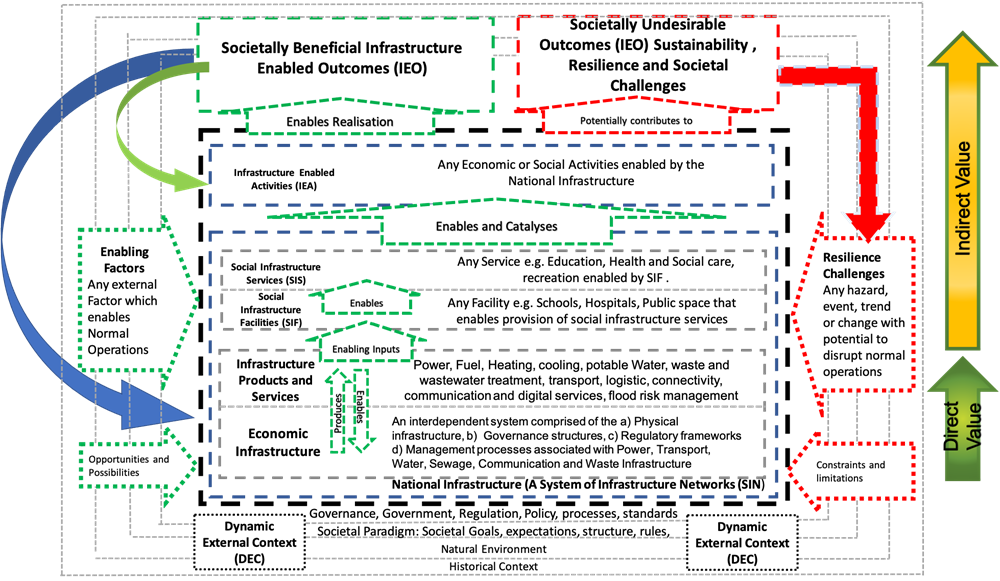FST BLOG
National Infrastructure – A Globally Significant Leverage Point for a Sustainable, Resilient, Net Zero Future
- 29 June 2021
- Environment
- Dr Tom Dolan

Preventing further global warming (reducing global Greenhouse Gas emissions to Net Zero), tackling other emergent sustainability challenges and enhancing societal resilience to all resilience challenges (including those driven by global warming - GWDRC) are deeply interdependent Wicked Problems. Collaborative, societal scale responses that are systemic in scope and focused on systemic transformation are required. In this article I argue that National Infrastructure is a societally significant leverage point the transformation of which into a Net Zero enabling, sustainability supporting, resilience enhancing system has a critical role to play in catalysing societal progress toward a sustainable, resilient, Net Zero future.
National Infrastructure (NI) is an open complex interdependent system comprised of the a) Physical infrastructure networks, b) Governance structures, c) Regulatory frameworks d) Management processes associated with the six economic infrastructure sectors of which it is comprised e) Interdependencies within and between each of the above f) Interdependencies with the Dynamic External Context (DEC) within which it is embedded (Figure 1).

Figure 1. Systemic Characterisation of National Infrastructure, Source: (Dolan 2021) and (Dolan 2021).
The normal operations of National Infrastructure produces a predictable flow of Infrastructure products and services (IP&S), supports provision of social infrastructure services (SIS), catalyses wider societal and economic activity (IEA), enables realisation of the societally beneficial outcomes (IEO) expected by the society it serves (Figure 1).
Our lifestyles, societies and economies are infrastructure enabled outcomes (IEO) made possible by National Infrastructure. Similarly, sustainability challenges such as the level of GHG emissions, air, water, noise pollution, solid waste and sewage produced by an infrastructure-enabled nation are also interdependent emergent properties (unintentional outcomes) that arise as a consequence of our lifestyles, societies and economies.
Therefore, the National Infrastructure that enables our lifestyles, societies and economies is also a driver of societal GHG emissions (hence global warming), other polluting emissions (sustainability challenges) and resilience challenges. Therefore, National Infrastructure is a societally significant leverage point:
- Capable of either catalysing (or impeding) reductions in GHG emissions across all levels of society and thus a key determinant of societal progress toward global Net Zero
- Capable of catalysing (or impeding) societal responses to other sustainability challenges
- Capable of either mitigating (or multiplying) the frequency, scale, intensity, duration of societal disruption caused by resilience challenges
To maximise the potential of National infrastructure as a societally significant leverage point and catalyst for synergistic society-wide progress toward a sustainable, Net Zero, resilient future. National Infrastructure must be transformed from a system that enables societally beneficial outcomes whilst simultaneously (albeit unintentional) causing sustainability and resilience challenges into a system which intentionally enables societally beneficial outcomes that possess the qualities Net Zero, resilient and sustainable.
Whilst, such a transformation will not guarantee success, it is nevertheless an essential component of any wider societal strategy. Quite simply, National Infrastructure without these qualities will all but guarantee Net Zero cannot be achieved. However, National Infrastructure with these qualities greatly increases the feasibility of success.
Systemic transformation of National Infrastructure into a system with these qualities cannot be achieved incrementally. Rather, a broad systemic focus on the following factors is required:
- The mindsets from which current system goals, structure and rules have emerged (Paradigms)
- The societal outcomes those systems are expected to enable (system goals/ purpose)
- The governance +++ structures and legal frameworks associated with associated with National Infrastructure (system rules) - Where Governance +++ Structures refers to all structures that influence how we govern, regulate, manage, plan, design, procure, construct, fund, finance, own, operate, maintain, account for, value, incentivise investment in, measure the performance of, and assess future need for National Infrastructure (Dolan, 2021)
- The mechanisms through which National Infrastructure fulfils it purpose(s) (System Structures)
Based on Thinking in System (Meadows, 2009).
Meaning, the systemic transformation of National Infrastructure will require the explicit integration of the qualities ‘Net zero enabling’, ‘Sustainability supporting’, ‘resilience enhancing’ into:
- The stated purpose of National Infrastructure i.e. the outcomes it is expected to enable
- All Governance +++ structures that influence National Infrastructure decision making
Moreover, until this happens National Infrastructure is more likely to exacerbate and impede, than catalyse, societal progress toward global Net Zero and other sustainability challenges.
Additionally the speed, scale and breadth of the required transformation needed, and the unprecedented level of interdisciplinary, cross-sectoral, society–wide collaboration this will require, necessitate the Launch of a Moonshot (CST, 2020) Mission (Mazzucato, 2021). Specifically tasked with establishing a diverse long-term, collaborative, dynamic, multifaceted, multi-scale, cradle-to-cradle and synergistic portfolio of systemically targeted interventions transform National Infrastructure into a Net Zero enabling, sustainability supporting, resilience enhancing system .
The systemic transformation of National Infrastructure has the advantage of being a multilateral action that can be replicated by all nations globally. Therefore, NI is a globally significant leverage point capable of catalysing global progress toward a sustainable, Net Zero resilient future.
Finally, given the predicted scale of global investment in National Infrastructure ($3.7 trillion per year every year between now and 2040) (Global Infrastructure Hub, 2017), and the prohibitively large opportunity cost of inaction, the systemic transformation of National Infrastructure is a global opportunity that must be seized if global Net Zero is to be achieved.
This opinion piece draws on the following sources:
- A Systemic perspective on a Resilient Net Zero Future (Dolan, In Press).
- National Infrastructure as Systemic Leverage Point to Enhance Societal resilience (Dolan, 2021)
- National Infrastructure a Societal Leverage Point for a Net Zero Economy (Dolan, In Press)
- Systemically Resilient National Infrastructure (Dolan 2020 in Chapter 5 of Intelligent Nation Beckford, 2020)
- Digitally Connected Infrastructure System Resilience Literature Review (Dolan et al, 2017 for NIC)
- Interdependence analysis for systemically resilient infrastructure systems (Dolan and Street, 2019 for CIRIA)
- Briefing: A systemic framework for infrastructure need assessment (Dolan, 2018)
- A conceptual approach to strategic performance indicators (Dolan et al, 2016)
- Purposeful and Systemic Infrastructure Governance – a pre-requisite for the creation of sustainable and inclusive cities (societies) (Dolan, 2016)
- Successful cities rely on resilient infrastructure (Dolan, 2019)
- The Role of Economic Infrastructure in Limiting Global Warming (Dolan, 2018)
- Systemically Resilient Prosperity: Adapting to and learning from COVID-19 (and other strategic challenges)(Dolan, 2020)
Dr Tom Dolan is a Senior Research Associate for UKCRIC Co-ordination Node at (EPSRC reference EP/R017727/1) University College London (UCL). Tom’s research focuses on complex infrastructure systems as enablers of societally beneficial outcomes. In particular, on the systemic interdependencies, emergent properties and dynamic context that underpin their normal operations and enable the realisation of systemic outcomes that are Net Zero; sustainable and resilient to the disruptive impacts of Global warming and other Resilience challenges; enhance the quality of the local environment; and helps catalyse an urgent transformation to a net zero GHG emission economy.
